| AJAX Error Sorry, failed to load required information. Please contact your system administrator. |
|
|
| Close | ||
| Loading..... |
About Sarawak
Sarawak History Before 1841, from the Brooke Era, Japanese Occupation, British Military Administration, Self Governing to Formation of Malaysia 1963
Sarawak Before 1841
The eastern seaboard of Borneo was charted, though not settled, by the Portuguese in the early 16th century. The area of Sarawak was known to Portuguese cartographers as Cerava, and by the early 19th century, Sarawak had become a loosely governed territory under the control of the Brunei Sultanate.
Sarawak, 1598
According to the Salasilah Raja-Raja Brunei, the Pengiran Muda Tengah Ibrahim Ali Omar Shah, better known as Raja Tengah, accepted the offer by his elder brother, the Sultan of Brunei, to be the Sultan of Sarawak in 1598. He brought along 1,000 warriors and a coterie of nobilities to help him administer the new country.
In 1599, while returning from Pahang, Sultan Tengah’s storm-lashed ship ran aground in Sukadana in West Kalimantan, Indonesia. He stayed and married there. On his return to Sarawak, he was killed by one of his followers at present day Kampung Batu Buaya in Santubong.
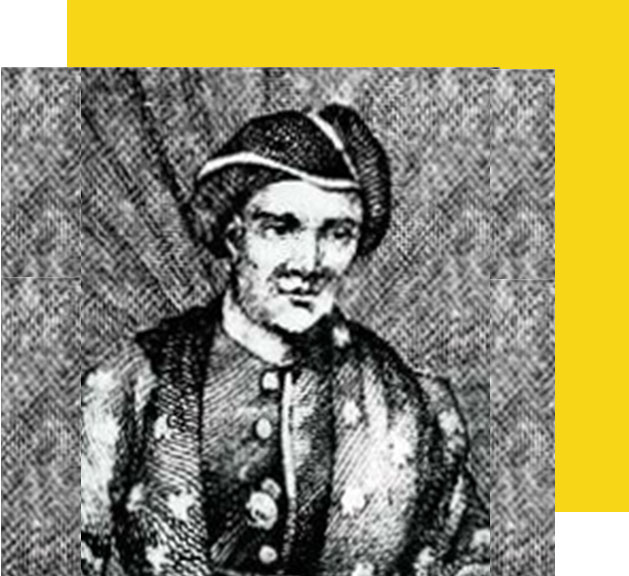
At the beginning of the 19th century, Brunei’s Sultan, Omar Ali Saif-Udin sent Pangiran Mahkota to Kuching to be the Governor of Sarawak. In 1836, the Malays and Land Dayaks (now known as the Bidayuhs) of the Sarawak River basin revolted and proclaimed their independence from Brunei.
The Sultan sent his uncle, Raja Muda Hashim, the Bendahara of Brunei, to put down the rebellion. However, it was unsuccessful as Pangiran Mahkota’s earlier appointment as the Governor was not withdrawn, resulting in a chaotic authority. At the same time, the rebellion led by Datu Patinggi Ali against the Brunei levies under Mahkota escalated. It was at the height of this unrest that a British adventurer and an exsoldier James Brooke first arrived in Kuching in 1839.
The Brooke Era (1841 - 1941)
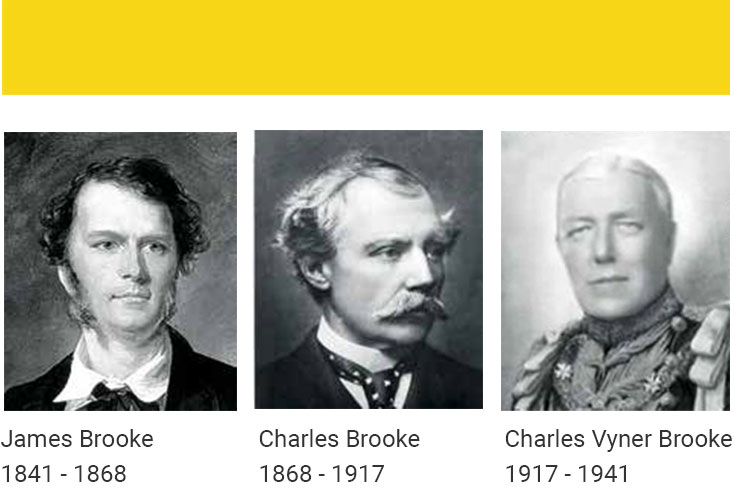 |
James Brooke had served in the East India Company’s army in his younger days. On his second visit in 1841, he agreed to help Raja Muda Hashim to quell the rebellion in Sarawak. As a reward, he was installed as the Rajah of Sarawak (which comprised the territory from Tanjong Datu to the Sadong River) in Kuching on 18 September 1842. Sarawak’s border continued to expand from Sadong River to Tanjong Kidurong until he was succeeded by his nephew, Charles Brooke in 1867. James Brooke died in England in 1868.
Under Charles Brooke, who ruled from 1868 until his death in 1917, the territory of Sarawak was extended to include Baram (1881), Limbang (1890) and Lawas (1905), and to its present boundaries. At this time, the government machinery was formalised with proper laws and order, and efforts were made towards economic development using technologies from the west.
Rajah Charles introduced public administration system, built a strategic network of fortresses, including Fort Margherita. The mass Chinese migration, growth of rubber plantation, oil prospecting in Miri, establishment of the Sarawak Museum, the famed Sarawak Rangers and Sarawak constabulary took place during his reign.
Charles Vyner Brooke, the second son of Charles Brooke, succeeded his father to become the third Rajah of Sarawak on 24 May 1917. The elder son Betram Brooke had earlier on declined the offer to rule. Vyner Brooke formulated a new constitution, which put an end to the absolute power of the Rajah in 1941. The Council Negri was given the power to ensure that no law could be passed or money spent without its consent.
During the century of Brooke rule, the Brooke authority was constantly challenged by the local indigenous leaders, most notably Sharip Sahap, Sharip Masahor, Rentap, Bantin and the Hakka gold miners from Bau led by Liu Shan Bang. However, the Brookes were able to contain all the uprisings.
The Japanese Occupation (1941 - 1945)
On 16 December 1941, Japanese forces landed at Brighton beach in Miri and scaled up Tanjong Lobang to reach the lighthouse where they killed the caretaker. The Japanese forces rapidly moved towards Kuching and occupied it on Christmas Eve that year.
When the Japanese invaded Sarawak, Vyner Brooke had already left for Australia where he operated in exile from Sydney, and subsequently moved to London. Most of the European officers in Sarawak were rounded up by the Japanese and interned at Lintang Camp (the present Batu Lintang Teachers’ Training College) in Kuching.
They were confined to trying conditions and many did not survive the ordeal. The administrative and economic infrastructures were severely damaged during the three-and-a-half year occupation. The Japanese forces built an iron bridge (which can still be seen today) across the Sadong River in Serian. The civilians also suffered much hardship as much of their rice crops were seized by the soldiers from The Rising Sun.
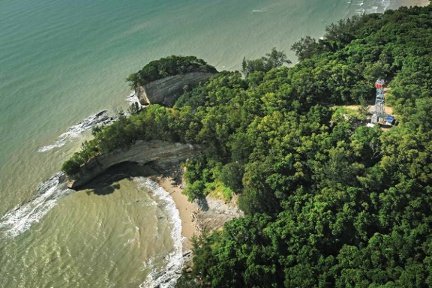
British Military Administration (August 1945 - April 1946)
Japan sought peace on 15 August, 1945 and all regular resistance to the occupation forces ceased on that date. The Australian armed forces under Major-General Wootten entered Kuching on 11 September 1945 to receive the formal surrender of the Japanese army in Sarawak, which was immediately placed under British Military Rule administered by the Australian Military until 15 April 1946.
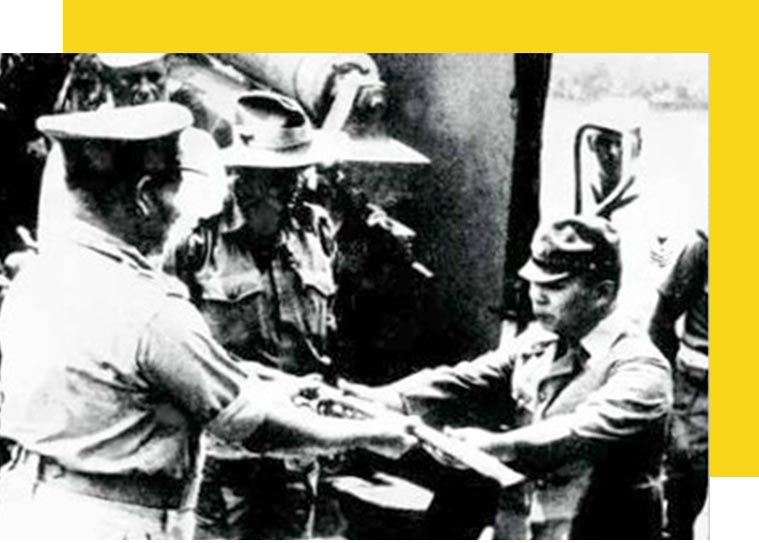
Major General H. Yamamura surrending his sword, 11 September 1945 in Kuching.
Sarawak as a British Crown Colony (1946 - 1963)
Vyner Brooke announced his intention to cede Sarawak to Britain in early 1946. The British government sent two Malay-speaking Members of Parliament to Sarawak to ascertain whether the people were in favour of cession. It was found that there was sufficient support for cession to be put before the Council Negri. This motion was subsequently debated for three days in the Council Negri. The Bill of Cession was read for the third time on 17 May 1946 and was passed by 19 votes against 16.
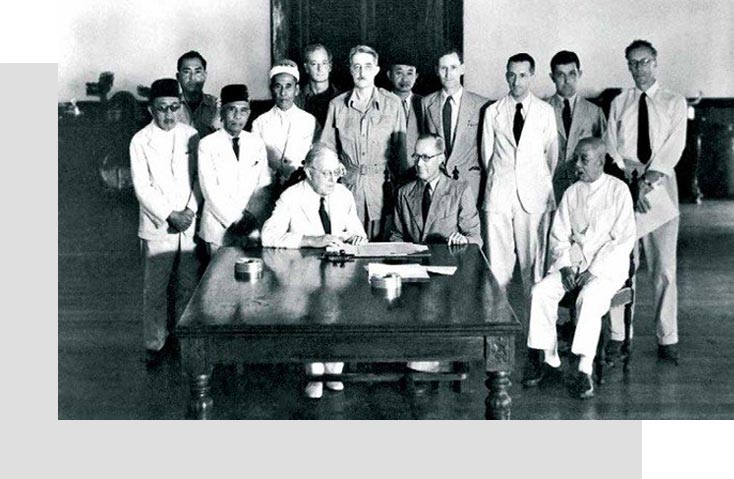
Rajah Vyner Brooke signing the Instrument of Cession at the Astana, Kuching, May 1946.
On 1 July 1946, Sarawak became a British Crown Colony with Sir Charles Arden Clarke made the first British Crown Colonial Governor.
The people of Sarawak were largely divided over the question of cession. The passing of the motion by a small European majority in the Council Negri did not end this issue. Dissatisfaction mounted and culminated in the mass resignation of the 388 Malay civil servants and the assassination of Sir Duncan Stewart, the Second British Governor in 1949 by Rosli Dhoby in Sibu. This marked the awakening of the political consciousness of the people of Sarawak. The British reaction to this attack was swift and the protest movement virtually died out by 1950.
The Council Negri remained as the governing body of the state. In 1956, a new constitution was promulgated. It gave an official majority tothe Council Negri for the first time. The first direct local government elections were held in November that year.
Self-Governing Sarawak 1963
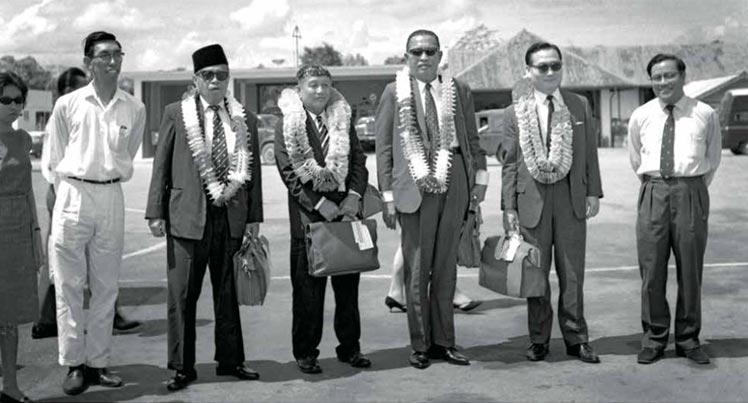
Sarawak Representatives at Kuching Airport on 12 July 1963 after returning from London where they signed the historic agreement to form Malaysia and end colonial rule
On 27 May 1961, Malayan Prime Minister Tunku Abdul Rahman Putra Al-Haj proposed a merger for closer political and economic co-operation between the Federation of Malaya, Singapore, Sarawak, North Borneo (as Sabah was known then) and Brunei.
British Prime Minister Sir Harold Macmillan supported the idea and the first Malaysia Solidarity Consultative Committee (MSCC) meeting was held in Singapore two months later, followed by an eye-opening visit by leaders from Sarawak and Sabah to Malaya on 12 August 1962. In 1962, a five-man team of 2 Malayans and 3 British representatives headed by Lord Cameron Cobbold conducted a referendum amongst Sarawakians on the proposed Federation of Malaysia.
The findings of the Cobbold Commission led to the Malaysia Agreement signed on 9 July 1963 by Malaya, Sabah, Sarawak and Singapore. As spelt out in the 20-point requirements raised by Sabah and 18-point by Sarawak, the Agreement sought to protect the interest, rights and autonomy of the people of the two states after the formation of Malaysia.
Temenggong Jugah anak Barieng OBE, Datu Bandar Abang Mustapa CBE, Abang Haji Openg, Ling Beng Siew and P.E.H. Pike signed on behalf of Sarawak while Tunku Abdul Rahman Putra Al-Haj and Sir Harold Macmillan represented Malaya and Britain respectively.
On 22 July 1963, the Governor of Sarawak, Sir Alexander Waddell, issued a proclamation to form the first Supreme Council with the appointment of Stephen Kalong Ningkan, the Chairman of Sarawak National Party (SNAP), as the first Chief Minister of Sarawak. The other members of the Supreme Council were Abdul Taib Mahmud, James Wong Kim Ming, Dunstan Endawie Anak Enchana, Awang Hipni Pengiran Anu and Teo Kui Seng. This marked the end of colonial rule and birth of Sarawak as a self-governing country.
Formation of Malaysia 1963
On 29 August 1963, the Yang Di-Pertuan Agong signed the Malaysia Declaration for the formation of the Federation of Malaysia. This was subsequently approved by the Sarawak Legislative Assembly on 4 September 1963 with 38 votes for and 5 against. A week later, Chief Minister Stephen Kalong Ningkan, 3 state cabinet ministers and 10 members of the Alliance flew to Kuala Lumpur to meet the Prime Minister and the Secretary of the Colony of Britain, Duncan Sandys, as an exciting new future beckoned for Sarawak.
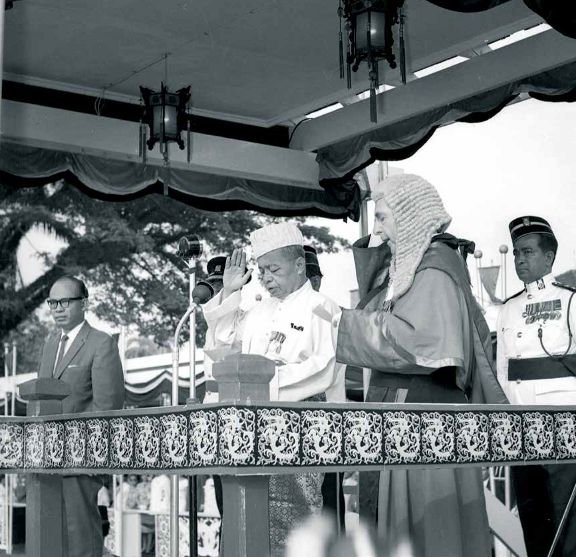
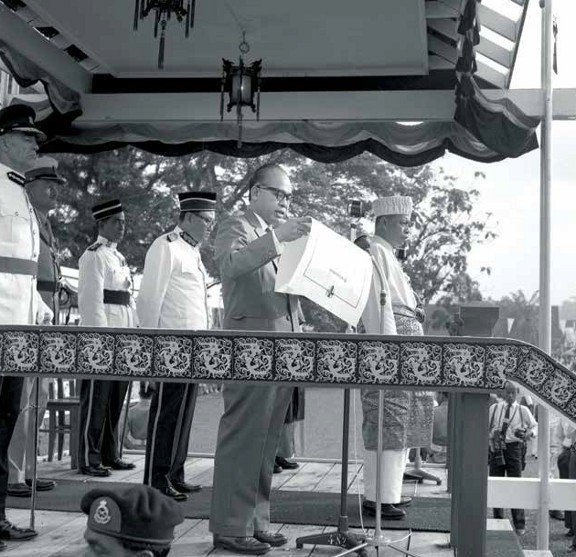
On 16 September 1963, the Honourable Khir Johari read the historic Proclamation of Malaysia witnessed by Datu Abang Haji Openg Abang Sapiee, the first Yang di-Pertua Negeri Sarawak, Datuk Stephen Kalong Ningkan, the Chief Minister, members of the first State Cabinet and the public at Central Padang in Kuching.
It was a poignant and proud moment when Ningkan read the Proclamation of the Independence of Sarawak: “Now therefore I, Stephen Kalong Ningkan, the Chief Minister of Sarawak, hereby proclaim that Sarawak has this day attained independence as a State of Malaysia”.
This was followed by the hoisting of the federal flag and the playing of the national anthem ‘Negaraku’. On this historical day, Sarawak achieved full independence as a member state of the Federation of Malaysia.
State Secretary
Sarawak State Secretary Office,
Level 20 , Wisma Bapa Malaysia
Petra Jaya, 93502 Kuching
Tel :1-300-88-7246
Fax :(60) 82-442522
Email: contactcentre@sains.com.my
Online: contactcentre.sains.com.my
Copyright © 2018-2025 Sarawak Government. All rights reserved
Disclaimer: The Government of Sarawak shall not be liable for any loss or damage caused by the usage of any information obtained from this portal. Services provided through this portal are subject to the terms and conditions of the respective providers
Best viewed with latest Firefox and latest Google Chrome in 1024 x 768 screen resolution.
No. of visitors 30405555
